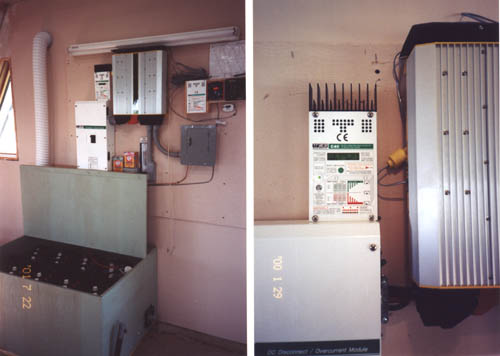The TRI-LEA-EM Electrical
System
The TRI-LEA-EM dome site is some 1500 feet (500 metres)
away from the road and electrical power distribution. In part for
this reason (access would have required a long and expensive pole
line) and in keeping with the desire for TRI-LEA-EM to act as an
environmental demonstration site, an off-grid electrical system was
installed. The system design criteria was as follows:
- building electrical usage estimated for 2 days in a weekend at
8400 watt hours
- 100 watt air to air heat exchanger motor for 16 hours = 1600
watt hours
- 10 x 15 watt compact fluorescent lamps for 8 hours = 1200 watt
hours
- water pump - 1/2 hp ~ 375 watts for 2.7 hours = 1000 watt hours
- projection equipment - 1000 watts x 3 hours = 3000 watt hours
- computer - 150 watts x 3 hours = 450 watt hours
- microwave - 800 watts x 1 hour = 800 watt hours
- audio equipment - 50 watts x 8 hours = 400 watt hours
Battery Rating Chosen - 700 Amp Hours at 24 volts = 16,800
watt hours, so that only half of the battery would be discharged in a
2 day usage period. 8 Trojan L16 cells were installed.
550 watts of Solar Panels (10 x Siemens SM-55) were
installed, originally chosen due to their compact physical size, with
the intent for direct roof top mounting. This was subsequently
revised to use pole mounting at the south facing dome side, to avoid
damaging the roof shingles. The intent was that the solar panels
could recharge the battery over a week assuming 2.2 hours of direct
sunshine per day x 7 days x 550 watts = 8400 watt hours. A Trace C-40
charge controller controls charging. The solar panels and related
equipment were supplied by
Backwoods Solar Electric
Systems, of Sandpoint, Idaho, and the inverter and batteries by
The Battery Post, Burlington, Ontario.
Home Power Magazine was a
great help in thinking out the system design, and John Wiles and Joe
Schwartz, both of whom write for Home Power Magazine were very
helpful in responding to questions about details before installation.
We thank them for their aid. It was a fun learning experience, and
has worked well. A schematic diagram of the system is shown below and
photos of the installed equipment. The TRI-LEA-EM site also has a
reliable wind resource, and some day a wind turbine may join the
solar panels, in particular for winter time support, but this has not
been required. The nice thing about solar panels is that their low
maintenance needs - occasionally sweep off snow during the winter
(although most just falls off) and water the batteries periodically
(which would also be needed with a wind based system). A gasoline
powered generator can be connected to charge the batteries in the
event of high demand and low sun, but so far it has only run about 2
hours in 4 years!

 The ventilated battery box sits below the charge
controller, the DC disconnect, and the inverter. Metering in the C-40
provides information on solar input, and accumulated solar in, and a
Trimetric Battery Monitor shows battery state of charge, and load
conditions. The Prosine 2500 Watt inverter was chosen as it supplies
a clean sine wave signal for computer, audio equipment, and
projection equipment as well as a built in charger that can be
supplied by the generator.
The ventilated battery box sits below the charge
controller, the DC disconnect, and the inverter. Metering in the C-40
provides information on solar input, and accumulated solar in, and a
Trimetric Battery Monitor shows battery state of charge, and load
conditions. The Prosine 2500 Watt inverter was chosen as it supplies
a clean sine wave signal for computer, audio equipment, and
projection equipment as well as a built in charger that can be
supplied by the generator.
 This composite shows the system being installed (covers
are not normally off!), the battery box, the solar panel mount (on a
schedule 40-4 inch pipe embedded in a concrete footing), and the
source of the energy (reflected in the building windows late one fall
evening).
Return to the first
construction page
This composite shows the system being installed (covers
are not normally off!), the battery box, the solar panel mount (on a
schedule 40-4 inch pipe embedded in a concrete footing), and the
source of the energy (reflected in the building windows late one fall
evening).
Return to the first
construction page
Go to next construction page -
Completing the Interior
Return to TRI-LEA-EM



